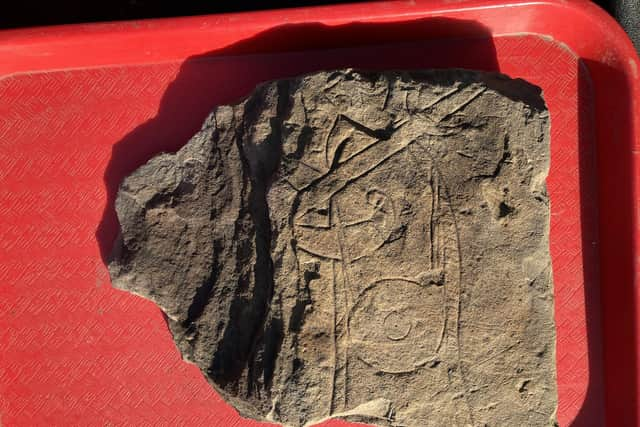Ancient 'Govan Warrior' sculpture found in Glasgow in 'remarkable' discovery
Meet the ‘Govan Warrior’, a carved fighter equipped with a round shield, sharply pointed beard and a flowing ponytail.
Probably created more than 1,000 years ago, the find has been hailed as a “remarkable” discovery in the grounds of Govan Old churchyard. The churchyard stands on a site once central to the lost Kingdom of Strathclyde and home to an exceptional collection of Viking-age sculptures from the period.
Advertisement
Hide AdAdvertisement
Hide AdThe ‘Govan Warrior’ was discovered by archaeologist Professor Stephen Driscoll, from the University of Glasgow. He said it was probably the most important find of his 30-year association with Old Govan, a religious and administrative centre of the early medieval Kingdom of Strathclyde that was likely a key stop-off site on routes that connected the ruling Pictish dynasties in the east of today’s Scotland with Ireland via the Isle of Man.


Prof Driscoll said: “This is probably the most important find that I’ve made in my 30 years of working at Govan Old.”
He said the stone was possibly carved in the early ninth century and compared it to both Aberdeenshire’s Rhynie Man, a Class I Pictish stone incised with an axe-carrying warrior, and military figures carved into the Dupplin Cross, which stands in Dunning in Perthshire.
Prof Driscoll said: “It’s a style that makes us think both about the Pictish world and also about the Isle of Man and it’s interesting that we are halfway between these two places. Govan is the ideal place for these two artistic traditions or styles to come together.
“The new stone is very exciting because it takes the collection to a different cultural place as it does not look like the heavier and chunkier ‘Govan School’ style. The new stone is much more delicate in its execution using finer shallow incisions.
“I think what it reinforces is the importance of Old Govan as the main place on the Clyde and we know there is a very strong connection between the Pictish heartland and Ireland.”
Prof Driscoll pointed to the marriage of the daughter of Kenneth MacAlpin, King of the Picts from 843 to 858, whose daughter Máel Muire ingen Cináeda married two High Kings of Ireland.
He said: “There was obviously travel back and forth as dynasties became connected and people would have been stopping off here. I think what our new stone reinforces is Govan Old’s nodal place on these routes between Scotland and Ireland.”
Advertisement
Hide AdAdvertisement
Hide AdResearch will continue into the ‘Govan Warrior’, which now sits amongst a collection that includes the Govan Sarcophagus, which is thought to commemorate St Constantine, the son of Kenneth MacAlpin, who went on to become King of the Picts between 862 and and 877. The collection also includes five hogback gravestones, a striking Scandinavian-style funerary monument that dates to the 9th and 10th centuries.
The Govan Warrior stone was discovered during a community fun day organised as part of the Glasgow Doors Open Days Festival, co-ordinated by Glasgow Building Preservation Trust.
More than 500 people visited the site over the weekend. Dozens of volunteers from the Govan community participated in excavations for the first time, alongside archaeology students from the University of Glasgow and Clyde Archaeology.
Comments
Want to join the conversation? Please or to comment on this article.